Flexible barge
A flexible barge is a fabric barge (non-rigid) for the transportation of bulk fresh water or other liquid bulk items such as chemicals or oil.

History
One such barge is called the Dracone Barge invented in 1956. Other similar devices are the Spragg Bag invented in the 1980s, the water bag proposed by Nordic Water Supply in the late 1990s and the more recent REFRESH modular waterbag, developed in the 2010s. Terry Spragg of Manhattan Beach, California, builds flexible fabric barges for the transportation of bulk fresh water and is the reason why his product is referred to as the "Spragg Bag."[1] In the 1970s Spragg was a promoter of icebergs as a large source of fresh water, but soon realized this was impractical.[2] He then put his skills into developing the waterbag technology starting in the 1980s. Spragg has worked on and perfected this over the last twenty years with his associates. The first field test of his waterbag was in December 1990.[3] The waterbag was 75 meters (246 feet) long and it contained approximately 3,000 cubic metres (790,000 US gal) of fresh water. It was towed from the Port Angeles harbor in the state of Washington. Another test was done in 1996 with a 100-mile (160 km) voyage from Port Angeles to Seattle, Washington.[4] This test ended on April 29 when the fabric of one of the two bags under tow developed a tear. Spragg says that his next goal is to run another test voyage demonstration between Northern and Southern California and a demonstration of the waterbag technology in the Middle East as well as around the world. There are various reasons why it has been difficult to gain support for demonstrating the viability of waterbag technology in California and around the world.[5][6] Spragg claims when two waterbags pass underneath the Golden Gate Bridge for the first time in history the media will let the whole world know about it.[7][8][9] A novel, Water, War, and Peace, has been completed that details the solutions waterbag technology offers to the complex political problems surrounding water issues throughout the Middle East, the United States, and the world.[10][11]
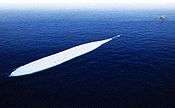
The Norwegian company Nordic Water Supply developed a 10.800 m3 bag in 1997 under an agreement with the Turkish government to transport freshwater to Northern Cyprus. Within two years at least 7 million m3 of water had to be delivered annually at a cost of €2.7M per year,[12] with volumes growing over time, but the actual transport only amounted to 4 million m3 in four years and the contract was discontinued by Turkish authorities. As a result, NWS went out of business and was de-listed from the Oslo Stock Exchange in 2003. NSW's waterbag technology was acquired by the Monohakobi Institute of Technology in Japan.[13]
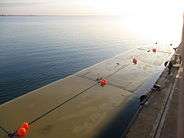
The REFRESH waterbag was developed by a consortium of companies and research institutes from Greece, Spain, Italy, Turkey and the Czech Republic within two European FP7 projects, REFRESH (running from 2010 to 2012) and the follow-up XXL-REFRESH (running from 2013 to 2015). The first project was focused on validation of the concept of modular waterbag; it developed a small scale prototype of 200 m3 capacity, tested in Greece in 2012.[14] The second project was focused on scale-up and partial redesign of the REFRESH system. At the end of the second project the REFRESH waterbag concept reached commercial scale and a 2500 m3 system made of five 500m3 modules was tested offshore Spain in 2015.[15] The length of the waterbag was 60 m long.
The REFRESH concept is different from concepts of waterbag proposed earlier, based on huge monolithic containers (as the one proposed by Nordic Water Supply) or "trains" of smaller containers each one being sealed in itself (as the Spragg bag). The REFRESH waterbag is made of a series of modules, each one being a cylinder open at both bases, joined by watertight zippers. This makes it possible to perform all "dry" operations on ground at the level of single modules, overcoming the handling problems of monolithic containers and improves the behaviour in navigation with respect to the "trains" of connected bags.
Technology
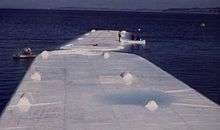
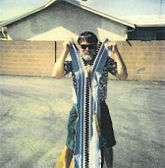
The 1995 associated Spragg patents (#5,413,065 and #5,488,921) indicate that the inventions relate to a flexible fabric barge technology or combination of several barges[16] made of a rubber polyurethane material. The main body portion of a flexible fabric barge is cylindrical in shape.[17] The barge can be used by itself or as several connected flexible fabric barges that can be towed through the open ocean under extreme conditions. The patents further explain that the goal of Spragg's inventions are a practical water delivery system of fresh drinkable water that could be delivered to dry regions worldwide that have a shortage of potable water.
One of the flexible fabric barge concepts aims at an economical delivery system for fresh water that would be considerably cheaper than desalination plants, rigid ships, tanker trucks, conventional barges, aqueducts or pipeline transport. Waterbags are more economical and better for the environment than desalination of the seas and oceans.[18]
The flexible fabric barge is a plastic container that is buoyant. It can be linked together with an attachment system to other flexible fabric barges to make a "train." The "waterbags", which are sometimes referred to as balloons or bladders, are made up of a vinyl lining inside a stronger material net.[19] It is a type of "fabric water pipeline" when several are strung together for transport of liquids by tugboat through seas or open oceans to remote locations.[17]
Zipper
Zippers play an important part in extending the capacity of the waterbag beyond what is practically achievable by a single textile piece. The Spragg and REFRESH concepts both feature prominently zippers, albeit with a fundamental difference in its function.
In the Spragg design, large waterbags are connected together like boxcars in a "train" fashion to increase the amount of liquids delivered at a time. It is estimated that the flexible barges could be as large as 14 meters in diameter and 150 meters in length, holding up to 17,000 cubic meters of fresh water or any other transportable liquid. Theoretically as many as 50 to 60 "waterbags" could be connected to one another and towed, although such a test has not been done to date.
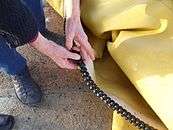
Engineers suggest that the fabric barge can hold a "train" of 4,500,000 US gallons (17,000 m3) of liquids.
A zipper coupler system is 10 times stronger than what is pulled by a 4,300 hp tug.[20] Laborde Marine estimates a 4,300 horsepower tug with a bollard pull of 110,000 pounds can pull a "train" of fifty or so flexible barges weighing up to 1,300,000 tons.[20] The "train" speed would be about 3 knots.[20] This is over 700 acre feet (8,600,000 hl) of fresh water or other liquid per trip.[20]
In the REFRESH design, the container itself is assembled on shore starting from planar cuts of fabric. Zippers run all along the perimeter of the fabric and make it possible to join an indefinite number of modules. Since each module is not closed by itself, zippers need to be watertight in order to ensure that no seawater leaks in.
Invention

The basic invention is a device for the delivery of huge amounts of fresh water (700,000 to 4,500,000 US gallons (17,000 m3) in each bag) at one time in a hostile wind and wave environment typical of oceans and large seas.[1] Since freshwater is lighter than seawater the filled "bladders"[21] (as they are sometimes referred to[22][23]) float on top, similarly to icebergs, with little above the surface and most below the surface. Fresh water can be taken from rivers just before it discharges into salty seas or oceans, which then would not interfere with salmon spawning.[17]
The associated coupler and zipper patent describes that to be economically feasible there should be several such flexible barges towed at one time. The greater the volume of water that can be delivered per trip, the better the economics. This string of barges would typically consist of barges in size from 25 to 50 feet (15 m) in diameter and 200 to 800 feet (240 m) in length each.
The unique characteristic of the Spragg Bag system is not the large volume of water in each bag, but what is called the world's strongest zipper (produced by Italian company Ziplast) that allows connection of several bags together in long trains.[24] The large connecting zipper can be operated manually or by remote control with radio signals. The string of such flexible fabric "waterbags" may be coupled to a barge via a reinforced fabric nose cone where a tow line is attached.
The REFRESH scheme is enabled by a specialty zipper, again developed by Ziplast, that uses a completely different tooth engagement design able to keep the strength of the original "Spragg" zipper while adding watertightness. Tests performed by the Spanish research centre AIMPLAS have confirmed that the zipper is able to stay watertight even when in tension.
Each "waterbag" is generally filled to 80-90% capacity (so that it is not stiff and remains able to adapt to deformations when turning) and is flat across its top.
Economics

One San Francisco area reporter writes that waterbag technology would provide economical fresh water delivery to the Monterey Peninsula district and a solution to the shortage of fresh water in the area. He reports that the average family of four uses one acre-foot of water a year. This costs over $1000 for delivery using conventional methods, however this same amount of water delivered by Spragg Bags would cost about 30% less.[8] Another newspaper reporter explains that towing Spragg Waterbags is environmentally friendly and is more economical than carrying water in ships or water tanker trucks or even using conventional rigid pipelines.[17] An article in the July issue of ECONOMIST Magazine in 2008 explains that worldwide there is enough water for all, however most is often in the wrong place at the wrong time and it is just too expensive to transport.[25]
Waterbag technology offers an easy and inexpensive solution to the problem of today's expensive conventional water transportation. It eliminates the difficulty of transporting water long distances by using the ocean as the means of transport. Waterbags considerably lower the capital costs and operating costs of moving fresh water from place to place. If a train was able to only move one or two box cars at a time, rather than in a train of dozens of boxcars at a time, it would not be very efficient and extremely expensive. Linking waterbags into "trains" of strings of waterbags and moving them through the ocean increases the economics of water transportation making it a viable practical option.[17]
The cost to transport water 300 to 800 miles (1,300 km) through the ocean, based on deliveries of 5 million US gallons per day (19,000 m3/d) to 10 million US gallons per day (38,000 m3/d), is estimated to be between $350 to $450 per acre foot, depending on the length of the voyage and the amount of water delivered per trip. Increasing the amount of water delivered per day in each waterbag train will help to significantly reduce the cost of the water delivered. Once the reliability of the waterbag delivery system has proven its economics and reliability it will just be a matter of adding more waterbags to the trains, and more trains to the system in order to increase the amount of water delivered to selected locations, while also reducing the cost of the water delivered. Based on the increasing reliability of the waterbag delivery system over time, it should be possible to be able to economically deliver 100,000's of acre feet per year to many coastal locations around the world.[17][26]
According to the inventor of the Spragg bag, the total cost of delivering fresh water down the California coast by his waterbag technology for a distance of 800 miles (1,300 km) from British Columbia to Monterey would cost about $966 per acre-foot per year. Keith Spain in a study for a Master Of Arts then shows in an analysis that it would save the residents of the Monterey Peninsula some $1,134 per-acre foot otherwise using a desalination plant. This is a savings of over $19 million per year for the Monterey taxpayers. This number assumes a usage of approximately 17,000 acre feet (21,000,000 m3) per year (17,000 X $1,134 = $19,278,000 savings).[27]
Applications
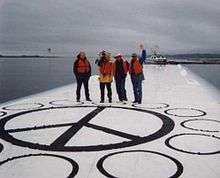
One application seen is in the Middle East where large quantities of fresh water that are available in the Turkey region could be delivered to other places around the Mediterranean Sea that have an extreme shortage of drinkable fresh water, like Israel and Gaza.[28][29] Spragg believes that delivering fresh drinking water to water-poor nations can promote world peace.[30][31]
Israeli President Shimon Peres has written a letter in support of implementing a demonstration of Spragg Bag technology in the Mediterranean Sea as a tool for helping to bring Peace to the Middle East. In this letter President Peres states, "The draft of WATER, WAR AND PEACE written as a novel is in my view an original approach to highlight this grave problem and its solutions, that will pave the path to a better and more peaceful region. Your efforts to embark on a demonstration voyage to enlighten us all, both regarding the technological viability as well as cost, will surely contribute to meet the critical dilemma."[32]
He also points out that using waterbags towed through the Mediterranean Sea would be much more economical than transporting water through pipeline systems.[33] This view is shared by the REFRESH consortium.[34]
Waterbags have been proposed to be used for emergency purposes in order to link the Gulf Cooperation Counsel countries' desalination plants all along the Persian Gulf coast.[35]
Another application is the regular delivery of fresh water over long distance routes.
Proposed routes include from the state of Washington to dry regions of Southern California, from Mad River in Northern California to the San Francisco area[36] and from Southern Chile to Atacama. Other applications are that it:
- could be used to move water through the Sacramento River Delta following an earthquake and a catastrophic levee collapse that could cut off Southern California's water supply for up to two years or more.[37]
- could deliver large quantities of stormwater and/or recycled water to areas that need more fresh water to offset lower water levels and rising salinity.
- could be pre-positioned storage worldwide of large quantities of fresh drinking water for quick delivery after a natural disaster.[7][38]
Spragg has proposed to deliver water from the Manavgat River in Turkey across the Mediterranean Sea to Israel and the Gaza Strip, which has an extreme shortage of water, which presently is being reviewed by the World Bank.[28][39]
Spragg has proposed to the Australian government that bulk fresh drinking water using his waterbag technology could be applied to urban water supplies that have a shortage. It would establish an economically sound new industry for bulk fresh water transport. An analysis of the economic and environmental advantages for waterbag technology by using the ocean currents from the Tully River to Brisbane, Queensland has been completed. On the Gold Coast the Tugan desalination plant is being built to supply 120 megaliters of drinking water daily at a cost of approximately $1.2 billion. Operation of the Tugan desalination plant will produce 235,000 tons of CO2 greenhouse gases annually. Preliminary cost estimates indicate that using waterbag technology to deliver the same amount of water from the Tully river to the Gold Coast may be 30 times less expensive than desalination, and that waterbag technology may emit 60 times less greenhouse gas. These figures suggest that waterbag technology would deliver water for much less cost than the proposed pipeline from the Burdekin River to Brisbane which is projected to cost approximately $7.5 billion for infrastructure and about $250 million for annual operation.[40]
Spragg has proposed to the White House the idea of a peace offering in the Middle East by supplying 20 to 30 of his waterbags with fresh water and transport them from Turkey to the Palestinians and Israelis.[41] The technology could also be used for the collection of Australia's factory waste water outputs, storm water, and sewerage for processing and reuse.[42]
Footnotes
- Waterbag web-site
- New times, Volume 11, p. 62, Newspaper "Trud", 1978, University of Michigan, Google Digitized Jan 30, 2008
- Waterbag History and Technology
- Gleick, p. 203
- Aguanomics: Persistance [sic] – and Baggs, February 14, 2009
- Aguanomics: Fear and Water Managers, September 18, 2009
- Emily Bouckaert Freshwater Delivery in the Wake of Natural Disasters, Circle of Blue, March 25, 2010
- San Francisco Chronicle, August 6, 1999
- Gulf oil spill: Should the U.S. Army Corps start dredging?, Los Angeles Times – Environment, May 20, 2010
- Water, War, and Peace (a novel)
- Water, War, and Peace by Terry G. Spragg & Associates, 1996
- Anderson, T.L. (2011). "Exporting Water to the World". Journal of Contemporary Water Research and Education.
- Uemura, Tetsuji (February 2011). "Blue gold in Japan: policy idea on creating a new water trading system coping with expected water issue in Japan based on comparison stuides" (PDF). NRI papers.
- "Euronews - Bags of water". Euronews. Retrieved 2016-02-22.
- "Euronews - the big bag theory: a cheap and innovative way to transport fresh water". Euronews. Retrieved 2016-02-22.
- Water imports using ocean routes, Section 1.4.3 Water Bags
- Lawrence Journal-World – April 27, 1996 p. 4
- Desalination vs. Waterbags
- Seattle Times-News, Feb 20, 1994, p. 30 Floating a plan to ship fresh water to California
- Bulk Water Exports – Status Report, May 11, 2010
- Giant water bags proposed to quench a dry planet's thirst, The Seattle Times, reprinted by Lawrence Journal – World – Apr 27, 1996, p. 4 The giant bladders, each which holds 4.5 million US gallons (17,000 m3)....
- Westneat, The giant bladders, each of which holds 4.5 million US gallons (17,000 m3), or as much water as 45,000 Seattleites use in a day, would form a flexible "fabric water pipeline" through the ocean.
- FRESH WATER – BY THE BAG INVENTION WILL HELP WORLD'S DRY REGIONS, MILLIONAIRE SAYS.
- WATERBAG TECHNOLOGY AND INTER-STATE WATER TRANSFERS
- ECONOMIST Magazine, July 19, 2008, Water A soluble problem.
- Gleick, p. 205
- Monterey Institute of International Studies Master of Arts in Commercial Diplomacy by Keith Spain
- Westneat, The San Diego Union – Tribune, April 28, 1996. p. A-3
- Popular Mechanics, March 1997, "Tech Update" Water goes by water
- "Forget OPEC. The next cartel may export drinking water" (PDF). Archived from the original (PDF) on 2010-06-10. Retrieved 2010-12-12.
- Fridell, p. 61
- Shimon Letter
- Waterbag technology may help solve water crisis in Middle East Archived October 12, 2012, at the Wayback Machine, Today's Zaman, March 20, 2009
- "Development of Modular reconfigurable waterbag for long haul freshwater transport over sea, presentation given at Malta Water Week 2015".
- Who has a spare $1m to prove that water can float?, The National, September 24, 2009
- Cup runneth Over, The journal, Humboldt County, California, cover story by Heidi Walters, Oct 22, 2009
- California's calamity in waiting, Los Angeles Times, November 20, 2005
- Safe water during disasters: Preparing better for the inevitable, Dr. Peter Gleick (President of Pacific Institute) October 5, 2009
- Danny Westneat Fresh Water – By The Bag – Invention Will Help World's Dry Regions, Millionaire Says, Seattle Times, April 26, 1996
- Ian Edmonds Northern River Water for Australian Cities
- "University of Rhode Island report of Christian Monitor report" (PDF). Archived from the original (PDF) on 2010-06-10. Retrieved 2010-12-12.
- Liz Penford speech
Sources
- Barlow, Maude, Blue Gold: The Battle Against Corporate Theft of the World's Water, Earthscan, 2003, ISBN 1-84407-024-7
- Fridell, Ron, Protecting Earth's Water Supply, Lerner Publications, 2008, ISBN 0-8225-7557-4
- Gleick, Peter H.; The world's water: the biennial report on freshwater resources, Volume 1998, pp. 203-205, Spragg Waterbags, ISBN 1-55963-592-4
- Lawrence Journal-World – April 27, 1996; Giant water bags proposed to quench a dry planet's thirst
- McCabe, Michael, San Francisco Chronicle, August 6, 1999; Full of Holes, or in the Bag
- Snitow, Alan, Thirst: fighting the corporate theft of our water, Publisher John Wiley and Sons, 2007, ISBN 0-7879-8458-2
- Westneat, Danny, The San Diego Union – Tribune, San Diego, Calif.:Apr 28, 1996. p. A-3, He hopes water-bag idea will float. 'Fabric pipeline' could slake thirst worldwide, [1,2 Edition]